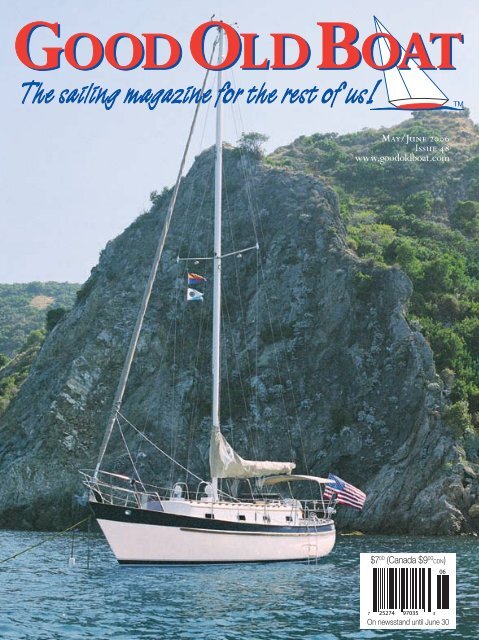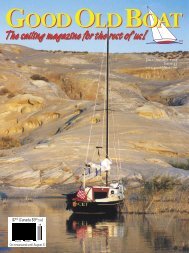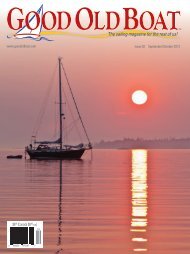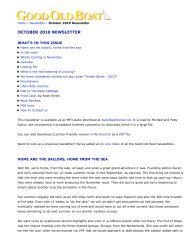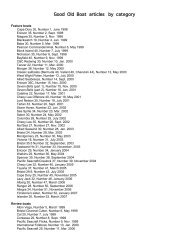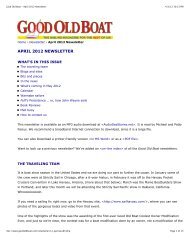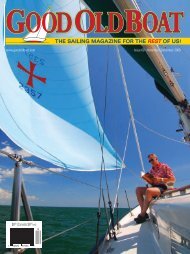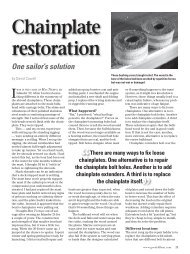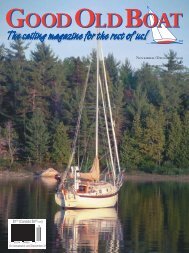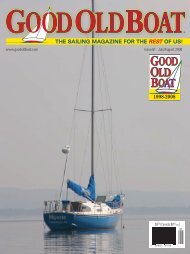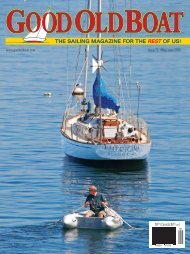The sailing magazine for the rest of us! - Good Old Boat Magazine
The sailing magazine for the rest of us! - Good Old Boat Magazine
The sailing magazine for the rest of us! - Good Old Boat Magazine
Create successful ePaper yourself
Turn your PDF publications into a flip-book with our unique Google optimized e-Paper software.
<strong>The</strong> <strong>sailing</strong> <strong>magazine</strong> <strong>for</strong> <strong>the</strong> <strong>rest</strong> <strong>of</strong> <strong>us</strong>!<br />
May/June 2006<br />
Issue 48<br />
www.goodoldboat.com<br />
$7 00 (Canada $9 00 CDN)<br />
06<br />
7 25274 97035 3<br />
On newsstand until June 30
Refit<br />
Scorpio 35 refit<br />
Hard work (pl<strong>us</strong> cash) saves a classic<br />
from <strong>the</strong> scrapheap<br />
by Barry Hammerberg<br />
STRIDER’S CLEAN WHITE DECK AND THE<br />
rich red paint job attracted our<br />
attention as she floated in her slip<br />
at Sugarloaf Marina in Port Colborne,<br />
Ontario. She looked new, yet she displayed<br />
classic lines. Intrigued, we wandered<br />
over to talk to Dave MacMillan,<br />
<strong>the</strong> owner, and learned that she had<br />
gone through a major refit.<br />
Dave’s bro<strong>the</strong>r, Joe, frequently<br />
cruised to <strong>the</strong> marina in Dover, Ontario.<br />
As many<br />
sailors are, he<br />
was inte<strong>rest</strong>ed in<br />
orphaned boats,<br />
those that were<br />
sitting on cradles<br />
while o<strong>the</strong>rs were<br />
<strong>sailing</strong>. Lost souls.<br />
He returned <strong>of</strong>ten<br />
to a flashy red-hulled sailboat that had<br />
been sitting in <strong>the</strong> parking lot <strong>for</strong> several<br />
years. He mentioned to Dave that<br />
this could be a very nice project boat;<br />
it j<strong>us</strong>t needed a little work. As Joe kept<br />
an eye on <strong>the</strong> boat, <strong>the</strong> price dropped<br />
annually from $69,000 through $29,000<br />
<strong>The</strong> broker agreed that <strong>the</strong> boat<br />
was about a season from becoming<br />
a total scrap, yet it appealed to Dave.<br />
to $20,000 (all prices in Canadian dollars).<br />
Dave decided to take a look.<br />
He and Joe headed to Dover one<br />
rainy day. As <strong>the</strong>y pulled into <strong>the</strong> yard,<br />
Joe pointed out <strong>the</strong> boat. Even in <strong>the</strong><br />
rain, <strong>the</strong> hull glistened, beckoning.<br />
She was bright red with a gold stripe<br />
accentuating her burgundy cap stripe,<br />
a nice paint job. This was not exactly<br />
Dave’s choice <strong>of</strong> colors, but she was<br />
attractive. He and Joe climbed her ladder.<br />
<strong>The</strong>re <strong>the</strong>y found a dirty, spongy<br />
deck with areas that flexed to <strong>the</strong><br />
point that Dave feared falling through.<br />
Inside <strong>the</strong> cabin it was raining j<strong>us</strong>t<br />
as hard as it was outside; water was<br />
dripping from <strong>the</strong> overhead. <strong>The</strong> broker<br />
agreed that <strong>the</strong> boat was about a<br />
season from becoming a total scrap,<br />
yet it appealed to Dave. This roomier<br />
35-foot project boat, when finished,<br />
would be larger and more com<strong>for</strong>table<br />
than his family’s Halman 27. All that<br />
was needed was a little money and a<br />
lot <strong>of</strong> work.<br />
Made an <strong>of</strong>fer<br />
Dave brought his wife, Diane, to look<br />
at <strong>the</strong> boat. After some thought, <strong>the</strong>y<br />
made an <strong>of</strong>fer and<br />
bought <strong>the</strong> boat<br />
<strong>for</strong> $12,000, about<br />
<strong>the</strong> cost <strong>of</strong> <strong>the</strong><br />
paint job on <strong>the</strong><br />
hull. <strong>The</strong>y were<br />
now <strong>the</strong> new owners<br />
<strong>of</strong> a Scorpio<br />
35, vintage 1981.<br />
It sorely needed attention. Undaunted,<br />
Dave figured o<strong>the</strong>rs had done it, and<br />
he could too. He had space in a heated<br />
building built <strong>for</strong> his earth-moving<br />
equipment. He had <strong>the</strong> boat hauled to<br />
his shop to begin <strong>the</strong> <strong>rest</strong>oration.<br />
<strong>The</strong> first thing on his list <strong>of</strong> projects<br />
4 GOOD OLD BOAT May/June 2006
A newly completed Strider on facing<br />
page, is not to be missed in <strong>the</strong> middle <strong>of</strong><br />
<strong>the</strong> o<strong>the</strong>r boats in <strong>the</strong> Buffalo Yacht Club<br />
basin be<strong>for</strong>e <strong>the</strong> Lake Erie Cruising Race.<br />
— be<strong>for</strong>e it caved in — was <strong>the</strong> delaminated<br />
balsa core deck. Dave decided<br />
to leave <strong>the</strong> interior in place to support<br />
<strong>the</strong> deck shape while <strong>the</strong>y worked on<br />
it. He removed all deck hardware and<br />
fittings: cleats, turning blocks, ports,<br />
everything. To preserve <strong>the</strong> original<br />
shape <strong>of</strong> <strong>the</strong> deck, Dave and Joe cut<br />
<strong>the</strong> outer skin <strong>of</strong>f <strong>the</strong> deck in sections.<br />
Dave was amazed at how thin <strong>the</strong><br />
skins were. He later learned <strong>the</strong> engineering<br />
principle <strong>of</strong> a cored structure<br />
that <strong>us</strong>es thin skins over a lightweight<br />
core to increase stiffness without creating<br />
excessive weight. As s<strong>us</strong>pected,<br />
<strong>the</strong> core was wet and, in many areas,<br />
rotted. Much <strong>of</strong> it was literally wood<br />
pulp that could be cleared away with a<br />
putty knife and wire br<strong>us</strong>h. A portable<br />
router with a bit set to <strong>the</strong> thickness <strong>of</strong><br />
<strong>the</strong> core cleanly removed <strong>the</strong> remaining<br />
balsa wood.<br />
<strong>The</strong>y set about rebuilding <strong>the</strong> deck.<br />
Section by section, <strong>the</strong>y sanded <strong>the</strong><br />
inner skin and troweled on a layer<br />
<strong>of</strong> filled epoxy. <strong>The</strong>y pressed new<br />
end-grain balsa core in place and<br />
vacuum-bagged it <strong>us</strong>ing a small medical<br />
vacuum pump and clear film. <strong>The</strong><br />
film allowed <strong>the</strong>m to see <strong>the</strong> epoxy<br />
flow through <strong>the</strong> core as <strong>the</strong> vacuum<br />
pressed it tightly to <strong>the</strong> inner skin.<br />
After a section <strong>of</strong> impregnated core<br />
hardened, <strong>the</strong>y sanded it, troweled<br />
ano<strong>the</strong>r layer <strong>of</strong> filled epoxy over <strong>the</strong><br />
core, and set <strong>the</strong> outer deck skin back<br />
in place. <strong>The</strong> vacuum was again applied<br />
to clamp <strong>the</strong> outer skin in place.<br />
<strong>The</strong>y repeated this process until <strong>the</strong><br />
entire deck was re-cored. As <strong>the</strong>y progressed,<br />
<strong>the</strong>y filled all <strong>the</strong> holes in <strong>the</strong><br />
deck, including <strong>the</strong> old portholes. <strong>The</strong>y<br />
added solid rein<strong>for</strong>cements where<br />
deck hardware would be placed. <strong>The</strong>y<br />
also added ABS plastic core <strong>for</strong> a pair<br />
<strong>of</strong> genoa tracks.<br />
Sanding and priming<br />
Once <strong>the</strong> deck was structurally<br />
sound, Dave and Joe went to work on<br />
<strong>the</strong> boat’s appearance. <strong>The</strong>y applied<br />
epoxy and fiberglass over <strong>the</strong> cuts<br />
<strong>the</strong>y’d made in <strong>the</strong> outer skin. Now<br />
came what Joe calls <strong>the</strong> boring part:<br />
sanding, applying epoxy primer, and<br />
sanding, repeating <strong>the</strong> steps until <strong>the</strong><br />
Dave MacMillan bonds <strong>the</strong> deck skins<br />
back toge<strong>the</strong>r, above, after <strong>the</strong> top skin<br />
was vacuum-bagged in place. O<strong>the</strong>r<br />
views at right from top: <strong>the</strong> balsa core is<br />
vacuum-bagged; Diane MacMillan wetsands<br />
<strong>the</strong> deck between layers <strong>of</strong> paint;<br />
<strong>the</strong> bow during painting; <strong>the</strong> cockpit at<br />
a similar stage; and Diane does finish<br />
work on <strong>the</strong> cherry tongue-and-groove<br />
planking which lines <strong>the</strong> hull.<br />
surface was true. <strong>The</strong>n <strong>the</strong> deck was<br />
sprayed with Awlgrip epoxy primer<br />
and sanded to a better-than-factorysmooth<br />
finish. <strong>The</strong>y followed this with<br />
a spray coat <strong>of</strong> Griptex mixed with <strong>the</strong><br />
first coat <strong>of</strong> Endura two-part polyurethane.<br />
A second coat <strong>of</strong> white Endura<br />
sealed <strong>the</strong> non-skid. <strong>The</strong> deck looked<br />
like it had j<strong>us</strong>t been released from a<br />
factory mold: fair and high gloss with<br />
no holes or cutouts.<br />
During deck reconstruction <strong>the</strong><br />
cockpit seats were slightly redesigned<br />
with rounder edges to make <strong>the</strong>m more<br />
crew-friendly. <strong>The</strong> teak planking on <strong>the</strong><br />
seats was replaced. <strong>The</strong> original teak<br />
cockpit floor grate also needed sanding<br />
and oiling, but it was <strong>the</strong>n re<strong>us</strong>ed.<br />
Dave remounted deck hardware in<br />
<strong>the</strong> original locations and added new<br />
running lights and genoa tracks. He<br />
cut new port openings and installed<br />
modern ports. Below <strong>the</strong> waterline he<br />
www.goodoldboat.com 5
Refit<br />
and Joe stripped <strong>the</strong> hull <strong>of</strong> all paint<br />
and gelcoat. Dave located templates<br />
and faired <strong>the</strong> keel. This task was<br />
complicated by <strong>the</strong> fact that previo<strong>us</strong><br />
owners had bought a shoal-draft kit,<br />
cutting <strong>the</strong> draft to 5 feet 4 inches and<br />
crudely adding a half bullet to each<br />
side <strong>of</strong> <strong>the</strong> base <strong>of</strong> <strong>the</strong> keel. Dave and<br />
Joe faired <strong>the</strong>se to create a smoo<strong>the</strong>r<br />
transition. <strong>The</strong>y applied Interlux Interprotect<br />
2000 barrier coating below<br />
<strong>the</strong> waterline, following <strong>the</strong> manufacturer’s<br />
instructions. Interlux VC-17<br />
provided <strong>the</strong> final finish.<br />
Interior shambles<br />
A year into <strong>the</strong> project, <strong>the</strong> exterior <strong>of</strong><br />
<strong>the</strong> boat looked great, but <strong>the</strong> interior<br />
was still in shambles. It would have to<br />
be rebuilt. <strong>The</strong> layout didn’t suit Dave’s<br />
needs, so he gutted <strong>the</strong> interior during<br />
<strong>the</strong> second winter <strong>of</strong> <strong>the</strong> project. Only<br />
<strong>the</strong> head remained in place, sans walls.<br />
He discarded all plumbing and wiring.<br />
He checked <strong>the</strong> hull’s balsa core and<br />
found it to be OK except <strong>for</strong> some damage<br />
around <strong>the</strong> through-hulls. <strong>The</strong>se<br />
areas were cut away and rebuilt to<br />
eliminate future seepage.<br />
Dave redesigned <strong>the</strong> interior with<br />
two aft quarter berths, a port galley,<br />
opposed saloon benches, and V-berth.<br />
He created a navigation station starboard<br />
aft <strong>of</strong> <strong>the</strong> head with cabinets to<br />
accept <strong>the</strong> electrical panels and electronics.<br />
It looked good on paper. Now<br />
Images at left: <strong>the</strong> completed cockpit<br />
and <strong>the</strong> completed deck. In <strong>the</strong> center:<br />
<strong>the</strong> completely rebuilt head and <strong>the</strong><br />
power panels. At right: <strong>the</strong> saloon and<br />
<strong>the</strong> galley.<br />
it was time to build it.<br />
He installed new cherry bulkheads,<br />
defining <strong>the</strong> cabin layout. He built<br />
cabinetry <strong>us</strong>ing cherry wood that<br />
was tabbed in place. <strong>The</strong>n he bonded<br />
¼ x 2½-inch strips <strong>of</strong> plywood to <strong>the</strong><br />
hull on 12-inch centers. He attached<br />
tongue-and-groove cherry planking<br />
with polyurethane glue and brads, effectively<br />
lining <strong>the</strong> hull — even behind<br />
<strong>the</strong> cabinets.<br />
Dave planed and grooved all <strong>the</strong><br />
cherry planking from rough kiln-dried<br />
stock. He ran out <strong>of</strong> planking and<br />
had to set up to make more, making a<br />
mental note to overstock next time he<br />
calculated a project. Beca<strong>us</strong>e he only<br />
needed to make one or two <strong>of</strong> everything,<br />
he felt he never got efficient at<br />
making any single component. <strong>The</strong><br />
wood was finished with satin-rubbedeffect<br />
varnish to naturally darken <strong>the</strong><br />
wood to a rich warm look.<br />
Cherry battens<br />
He bonded wood strips to <strong>the</strong> overhead<br />
to accept screws <strong>for</strong> mounting<br />
<strong>of</strong>f-white vinyl wrapped panels. Cherry<br />
battens held <strong>the</strong> overhead panels in<br />
place. <strong>The</strong> results looked pr<strong>of</strong>essional.<br />
During <strong>the</strong> construction <strong>of</strong> <strong>the</strong><br />
interior, Dave installed 12v DC and<br />
110v AC wiring and led this to <strong>the</strong> new<br />
panel locations. <strong>The</strong> electrical cabinets<br />
were built with key locks that opened<br />
to reveal wiring and junctions, all arranged<br />
<strong>for</strong> easy service. <strong>The</strong> interior is<br />
stunning.<br />
<strong>The</strong> engine had low hours and was<br />
in good condition. A new, 2-bladed<br />
folding propeller finished <strong>the</strong> propulsion<br />
system. Dave was able to clean<br />
and re<strong>us</strong>e all <strong>the</strong> original tanks. Fortunately,<br />
<strong>the</strong> sails were good enough<br />
<strong>for</strong> a season, allowing him to select a<br />
new inventory based on future needs<br />
after <strong>sailing</strong> <strong>the</strong> boat <strong>for</strong> a season. <strong>The</strong><br />
current sail inventory is a 2004 main; a<br />
light and heavy #1, circa 1985; a Mylar<br />
#2, circa 1995; a #3, circa 1990; a cruising<br />
spinnaker; and two symmetrical<br />
spinnakers.<br />
6 GOOD OLD BOAT May/June 2006
Twenty months<br />
passed be<strong>for</strong>e this<br />
awesome project was<br />
completed. <strong>The</strong> boat was<br />
christened Strider and<br />
launched July 2, 2003. Un<strong>for</strong>tunately,<br />
Dave’s work prevented his attendance<br />
at <strong>the</strong> launching, but Joe and his wife,<br />
Linda, helped <strong>the</strong> yard step <strong>the</strong> mast.<br />
Joe delivered Strider to Dave’s slip<br />
without incident.<br />
When I asked if he had ever looked<br />
at <strong>the</strong> mess and wondered what he’d<br />
gotten into, Dave replied that he’d<br />
enjoyed every step beca<strong>us</strong>e it was a<br />
learning process and a challenge. <strong>The</strong><br />
results, he said, were always gratifying.<br />
He had Joe, Diane, and ano<strong>the</strong>r<br />
friend, John, to help him throughout<br />
<strong>the</strong> project.<br />
Longer than expected<br />
“What was <strong>the</strong> worst part?” I wondered.<br />
“<strong>The</strong> last few weeks were hard<br />
beca<strong>us</strong>e every step seemed to take<br />
longer than expected,” he told me. Joe<br />
In <strong>the</strong>se races Strider was<br />
a real eye-catcher. She is essentially<br />
a new boat with classic looks.<br />
noted that sanding was <strong>the</strong> part he<br />
liked least. Looking back later, Dave<br />
said he’d figured <strong>the</strong> project wrong. He<br />
had expected a lot <strong>of</strong> work and a little<br />
money. Well, he’d missed <strong>the</strong> target<br />
on <strong>the</strong> cost. He figured he had about<br />
$30,000 Canadian in <strong>the</strong> refit. Based on<br />
<strong>the</strong> results, it’s still a bargain.<br />
Strider races out <strong>of</strong> Port Colborne,<br />
Ontario, in <strong>the</strong> Wednesday-evening<br />
fleet. We caught up with Dave and had<br />
<strong>the</strong> chance to take photos during <strong>the</strong><br />
2005 Lake Erie Interclub Race series<br />
(three distance races between <strong>the</strong><br />
U.S. and Canada and two triangular<br />
courses). In <strong>the</strong>se races Strider was<br />
a real eye-catcher. She is essentially a<br />
new boat with classic looks.<br />
When asked why he chose <strong>the</strong> name<br />
Strider, Dave replied, “When I read<br />
Lord <strong>of</strong> <strong>the</strong> Rings, I felt Strider was a<br />
cool character: a ranger<br />
who quickly and quietly<br />
roamed <strong>the</strong> kingdoms.”<br />
To Dave, that’s what <strong>sailing</strong><br />
is all about: quietly<br />
and quickly roaming <strong>the</strong> seas. That’s<br />
exactly what Strider does.<br />
Scorpio 35<br />
Builder: Scorpio Yachts<br />
Located: London, Ontario<br />
Year: 1981<br />
LOA: 35 feet 0 inches<br />
LWL: 26 feet 6 inches<br />
Draft: Was 5 feet 10 inches;<br />
Mars Metal bulb kit shortened to<br />
5 feet 4 inches<br />
Beam: 11 feet 2 inches<br />
Engine: Yanmar 2GM (15-hp)<br />
Tankage: 15 gallons fuel, 30 gallons<br />
water, 30 gallons holding tank<br />
Construction: Balsa-cored fiberglass<br />
deck and hull<br />
Pay<strong>of</strong>f time after all <strong>the</strong> hard work:<br />
Strider sails beautifully. Strider’s chute<br />
is up <strong>for</strong> a light-air Tuesday-night race.<br />
www.goodoldboat.com 7


